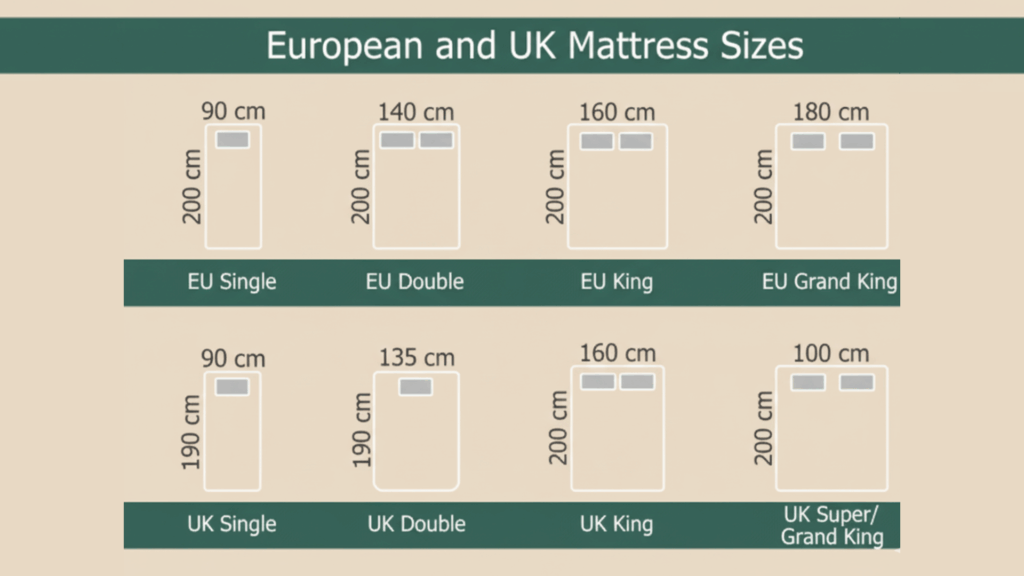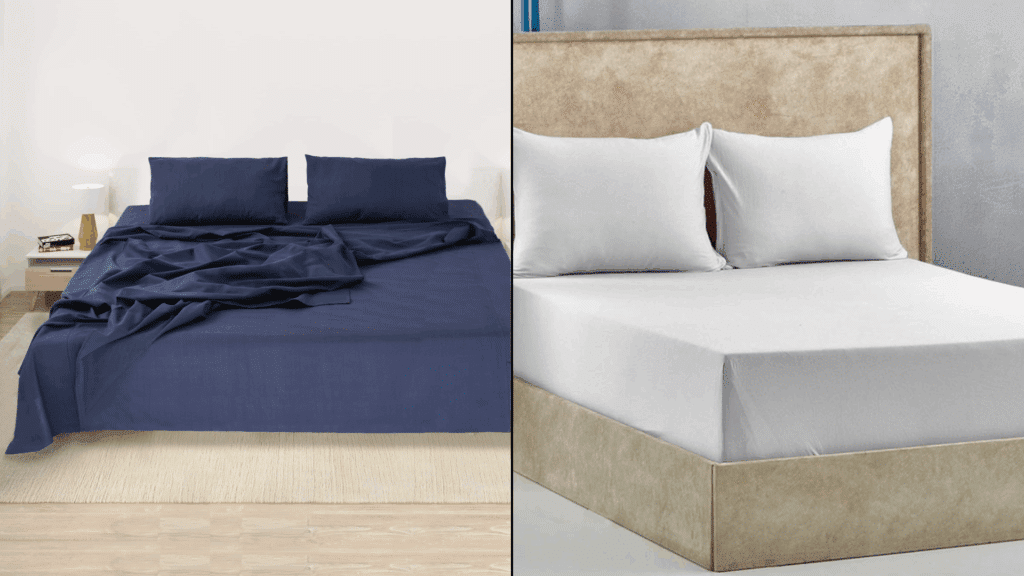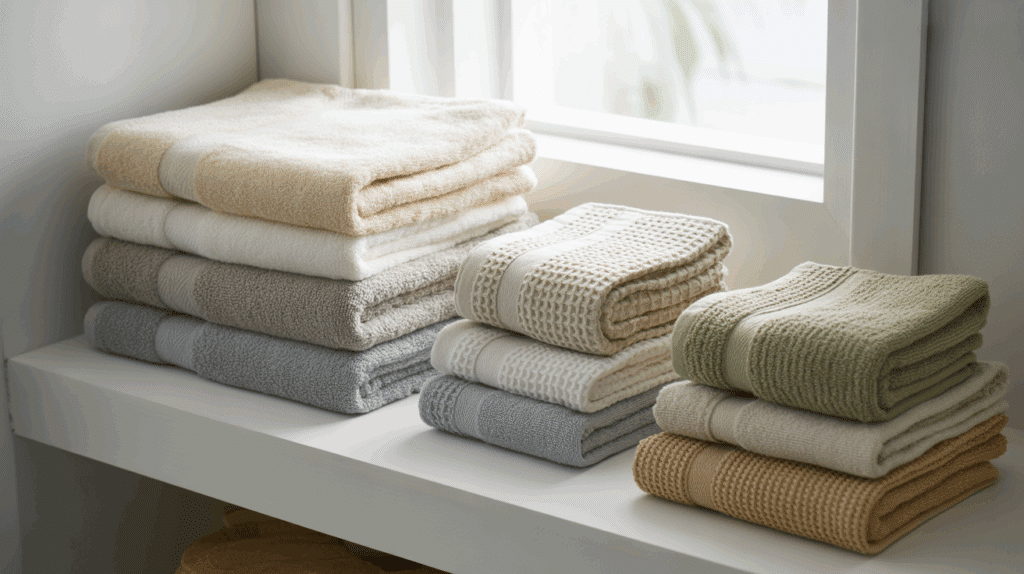I’ve moved across countries twice, and nothing confused me more than trying to match a mattress to my old frame.
You think a queen is a queen everywhere, until your sheets don’t fit and the bed sticks out past the wall. That’s when I learned just how different European bed sizes are from the ones in the U.S.
If you’ve ever struggled to compare inches and centimeters or wondered why a “king” isn’t always king-sized, you’re not alone in that mix-up.
In this guide, I’ll help you make sense of those measurements, compare both systems clearly, and show you how to pick the right fit for your room. So, let’s get started.
Quick Answer: European Bed Sizes vs. American Bed Sizes

The main difference between European and American bed sizes comes down to measurement systems and naming.
The U.S. uses the imperial system (inches), while Europe follows the metric system (centimeters). This difference might seem small, but it has a big impact when buying or fitting mattresses across regions.
Because of this, even beds that appear similar, like a U.S. queen and a European king size bed, rarely match perfectly. American beds tend to run wider, partly because homes in the U.S. generally have more space.
In Europe, mattress dimensions can vary by country, and names like “king” or “double” don’t always represent the same measurements.
Below is a quick chart comparing the closest equivalents across both regions. Use it to check compatibility before buying or shipping a mattress overseas.
Remember, small differences can affect how well your frame, mattress, and bedding fit together. Always trust dimensions, not labels.
| U.S. Size | Inches | Closest EU Size | Centimeters |
|---|---|---|---|
| Twin | 38 × 75 | Single | 90 × 190 |
| Twin XL | 38 × 80 | Single Long | 90 × 200 |
| Full | 54 × 75 | Double | 140 × 200 |
| Queen | 60 × 80 | Euro King | 160 × 200 |
| King | 76 × 80 | Super King | 180 × 200 |
| California King | 72 × 84 | Euro Cal King | 180 × 210 |
Why Mattress Sizes Differ Between Regions
Mattress sizes vary between Europe and the United States because of three main factors: measurement systems, naming standards, and housing design.
The U.S. follows the imperial system, measuring in inches, while Europe uses the metric system, measured in centimeters. This leads to small but important size differences; just a few centimeters can make a bed frame or sheet incompatible.
Naming adds to the confusion, since a “king” or “queen” label doesn’t mean the same thing across regions. Beyond that, cultural and architectural differences shape design choices.
American homes often have larger bedrooms that accommodate wider and longer beds, while European rooms are typically smaller, prompting more compact and efficient mattress sizes tailored for tighter spaces.
Regional Variations Across Europe
Mattress dimensions across Europe aren’t fully standardized. Sizes vary by country, reflecting cultural preferences and room size differences.
UK and Continental Europe Mattress Sizes

The U.K. and continental Europe share some similarities but still differ in width and length.
U.K. mattresses tend to be slightly shorter, while continental European sizes follow neat metric measurements like 90, 140, 160, and 180 centimeters in width. Here’s how they compare:
| Name | Centimeters | U.S. Equivalent |
|---|---|---|
| Single | 90 × 190 | Twin |
| Double | 135 × 190 | Full |
| King | 150 × 200 | Between Full & Queen |
| Super King | 180 × 200 | U.S. King |
| Small Double (EU) | 120 × 200 | Rare in the U.S. |
| Double (EU) | 140 × 200 | Slightly wider than Full |
| Euro King | 160 × 200 | Most common for couples |
| Grand/Super King (EU) | 180 × 200 | Near U.S. King |
Scandinavian and Italian Mattress Variations

Different parts of Europe follow unique sizing conventions based on regional habits and design trends:
- Scandinavia: 120 × 200 cm, often called a large single, popular in small modern homes.
- Italy: 180 × 210 cm, an extra-long option designed for taller sleepers and large family beds.
These variations show how flexible European sizing can be, underscoring the importance of checking exact measurements when shopping internationally.
Compatibility Guide: Frames, Sheets, & Bedding
Even when mattress sizes appear close, slight measurement differences can cause fitting issues with bed frames, sheets, and bedding.
Bed Frames

Bed frames are designed with specific tolerances, meaning even a small difference in size can create problems.
U.S. bed frames use inch-based measurements, while European models are made using centimeters.
A gap of just one or two centimeters can make the mattress shift or leave space along the edges.
European frames often use slats that don’t always align with thicker U.S. mattresses.
Always measure the interior dimensions of your frame before buying or importing a mattress, and check that the height and support system are compatible for long-term comfort and durability.
Fitted Sheets & Mattress Depth

Fitted sheets are the most common cause of incompatibility when mixing regions.
American fitted sheets are made for deeper mattresses, often between 12 and 16 inches thick, while many European mattresses are thinner. This difference can lead to loose or wrinkled sheets that don’t stay in place.
To ensure a proper fit, always measure your mattress’s depth and compare it to the pocket height listed on the packaging. When buying across regions, consider using adjustable straps or flat sheets to avoid slipping or excess fabric.
Traveler’s Section: European Hotel Bed Setups
European hotels feature smaller rooms, flexible bed setups, and compact designs compared to the United States. Here’s what travelers should know:
- Rooms are typically smaller, especially in older city hotels.
- Bed sizes vary widely between countries and hotel classes.
- Many hotels use adjustable twin or “zip link” beds.
When booking your stay, expect double beds that are close in size to a U.S. full mattress. In many cases, two twin beds are joined together to form a larger sleeping surface. This setup allows hotels to switch between single and double occupancy easily.
To ensure comfort, specify your preference in advance. Ask for “one 160×200 mattress” if you want a single bed surface, or request “two singles joined” if you’re fine with a split design.
Families or groups should clarify bed arrangements since triple or quad rooms often combine different mattress types.
Bonus Tip: Pack adjustable sheet straps or a light flat sheet to keep bedding smooth. Twin beds pushed together can leave a small gap in the center, and straps help create a seamless surface for better sleep.
How to Measure and Convert Like a Pro
Accurate measuring ensures your mattress fits perfectly, especially when mixing U.S. and European sizes. Follow these simple steps for precise results.
Step 1: Measure the interior width and length of your bed frame using a firm tape measure to confirm the exact sleeping surface size.
Step 2: Convert your measurements from inches to centimeters, or vice versa, using an online calculator or a reliable size chart for consistency.
Step 3: Compare your converted measurements to the closest regional mattress standard to find an accurate U.S. or European equivalent.
Step 4: Leave about one to two centimeters of clearance between the mattress and frame to allow easy placement and airflow.
Quick Conversion Chart (in ↔ cm):
| Inches | Centimeters |
|---|---|
| 1 | 2.54 |
| 38 | 97 |
| 54 | 137 |
| 60 | 152 |
| 76 | 193 |
Buying Advice for Cross-Region Shoppers
When purchasing a mattress from another region, always start by measuring your bed frame’s interior width, length, and height to ensure compatibility.
Convert these numbers into the correct unit, inches or centimeters, and use a reliable conversion chart to compare against standard mattress dimensions.
Make sure your bedroom has enough space for movement and accessories like nightstands or dressers once the bed is placed.
Before placing an order, double-check every detail: confirm measurements are all in the same unit, review the store’s return or exchange policy, and verify that bedding, toppers, and protectors are available in matching sizes.
Also, measure doorways, staircases, or hallways to confirm that your new mattress can be delivered without issues.
If you’re sourcing European sizes, trusted options include IKEA, Emma Sleep, Wayfair EU, Dormeo, and Amazon Global.
Always review shipping fees, import taxes, and warranty terms before finalizing your purchase, as international returns can be expensive or restricted.
Conclusion
By now, you’ve seen how a few centimeters can completely change the way a mattress fits, or doesn’t.
Understanding European bed sizes isn’t just about numbers; it’s about avoiding frustration, wasted money, and mismatched bedding.
I hope this breakdown helped you feel more confident choosing the right size for your frame, whether you’re shopping locally or abroad. The next time you compare dimensions, remember to trust the measurements, not the names.
Have you ever had to adjust your setup for a bed from another country? I’d love to hear your experience. Keep reading my related guides to learn more about mattress compatibility and smart bedroom planning.









